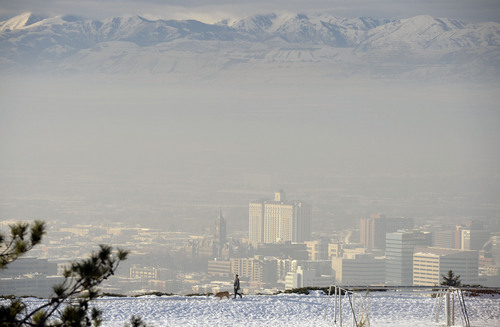This is an archived article that was published on sltrib.com in 2014, and information in the article may be outdated. It is provided only for personal research purposes and may not be reprinted.
Salt Lake City exists in a high altitude bowl surrounded by mountains, making us more vulnerable to pollution build up than other major cities. We all get that.
Too often in response, we hear, "Well there's not much we can do about it." Replying to a citizen's e-mail question, "What can we do about our air pollution?" one of our legislators replied, "We could pray for a storm." He wasn't joking.
Last year, at a press conference Gov. Herbert responded to a similar question with, "You could get me a new weatherman." I hope he was joking.
Last winter, after the international media bestowed upon us the distinction of having had the worst air pollution in the country, our governor told the New York Times, "We're doing everything we can to make sure it is improving, and in fact, it is."
Unfortunately, that was the biggest joke yet, albeit cruel and unintended.
Here, in truth, is what "doing everything we can" looks like:
Mexico City has geography similar to Salt Lake City, surrounded by stunning, snow-capped mountains reaching even higher than ours — 17,000 ft. By 1990 Mexico City was named the most polluted city in the world by the United Nations.
Stories of birds dropping dead in flight were legendary. Mexico City was worthy of the name, the "Desolation of 'Smog,'" long before the Hobbit movie came out. It was considered the most dangerous city for children to grow up in.
Then a funny thing happened on the way to pollution ignominy. Residents and politicians decided geography was no longer an excuse for breathing toxic air.
They added a suburban train, a low-emissions bus system, dedicated a highway lane to the "Metrobus," and launched bike sharing. They initiated programs to get old, high polluting cars off the road.
Monitors were placed all over the city, and they started monitoring chemicals like the highly dangerous and cancerous benzene. All diesel engines were required to be retrofitted with the equivalent of a catalytic converter.
One day a week cars were ordered off the road, a program called "Hoy no Circula," or "No driving today." Polluting businesses were relocated.
But the most dramatic move to improve air quality in Mexico City was the sudden shut down in 1991 of the largest oil refinery in the country.
Because the city had grown up around the plant, it was now in a densely populated neighborhood. It covered 430 acres, took 100,000 barrels a day out of production, and cost $500 million dollars to dismantle.
In announcing the shutdown to a standing ovation of government officials, Mexican President Carlos Salinas de Gortari said, "The government is prepared to impose upon itself the most severe measures to protect public health and to respond to social demands. Let's plant trees where today there is nothing but pipelines."
The refinery was replaced with public parks and green space.
"If the government decides to do something about it, it can be done," said Nobel Prize-winning air quality expert Mario Molina. "There's really no excuse not to do more."
Twenty years later, despite continued growth — including doubling the number of cars to 4.2 million and an increase in the population to 20 million — Mexico City has cut most of its pollution components at least in half.
The notorious PM2.5, the pollution that so plagues Salt Lake City, has dropped 70 percent and ozone 75 percent. In 1992, only eight days had air quality considered "good," but in 2012, 248 days qualified as "good."
Yes, other cities face similar geographic handicaps to Mexico City and Salt Lake City — Denver and Los Angeles to name two — yet they have made real progress.
But Utah's political leaders ask for new weathermen and tell us to pray for a storm, while allowing our largest polluters to expand.
What we should pray for is a political storm, for new leaders who don't treat cleaning up our air as a joke, who don't use our geography as an excuse, who really "decide to do something about it." The largest clean air rally the state has ever seen will take place at the Capitol, Jan. 25 at noon: "Clean Air, No Excuses Rally." Mexico City has proven, "It can be done."
Brian Moench is president of Utah Physicians for a Healthy Environment and a member of Union of Concerned Scientists.



